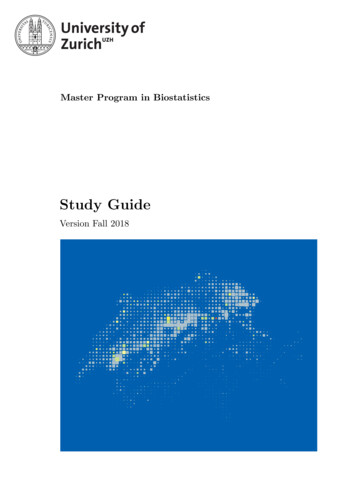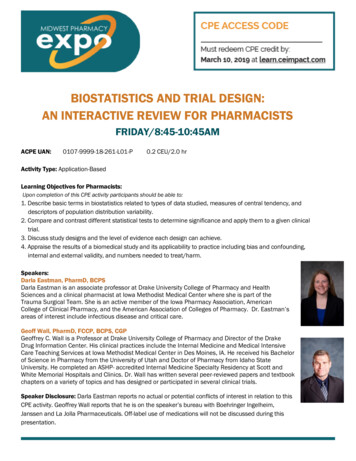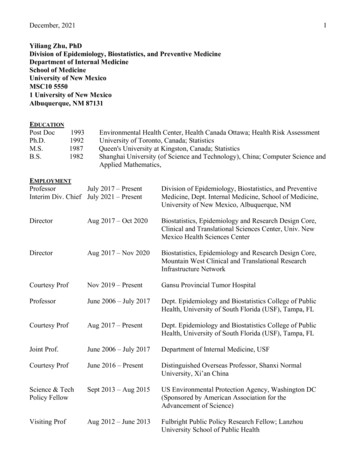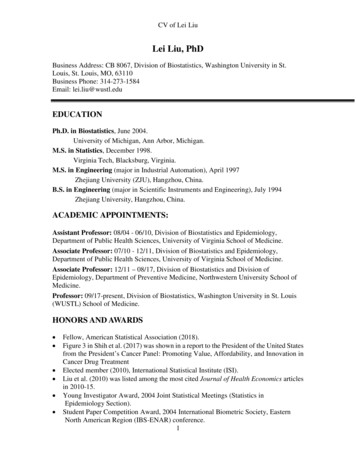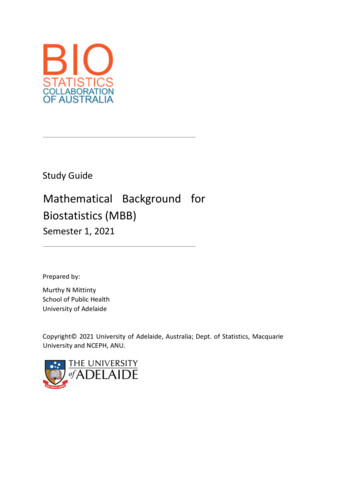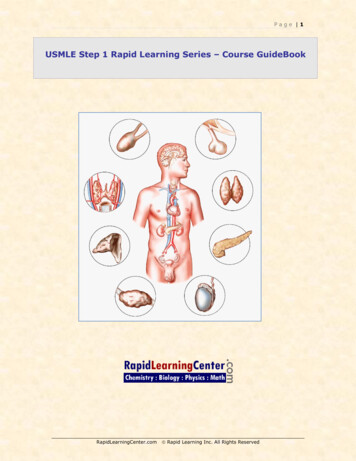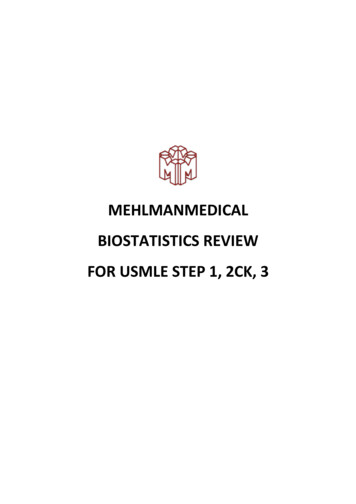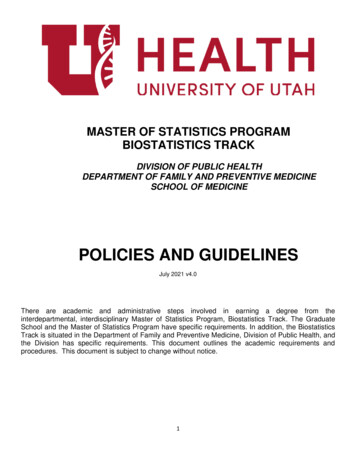
Transcription
MASTER OF STATISTICS PROGRAMBIOSTATISTICS TRACKDIVISION OF PUBLIC HEALTHDEPARTMENT OF FAMILY AND PREVENTIVE MEDICINESCHOOL OF MEDICINEPOLICIES AND GUIDELINESJuly 2021 v4.0There are academic and administrative steps involved in earning a degree from theinterdepartmental, interdisciplinary Master of Statistics Program, Biostatistics Track. The GraduateSchool and the Master of Statistics Program have specific requirements. In addition, the BiostatisticsTrack is situated in the Department of Family and Preventive Medicine, Division of Public Health, andthe Division has specific requirements. This document outlines the academic requirements andprocedures. This document is subject to change without notice.1
Table of ContentsPage4Brief Introduction to MSTAT ProgramHistoryMissionBiostatistics TrackMSTAT Biostatistics Track Faculty5Admissions CriteriaMSTAT Program Admissions CriteriaAdditional Biostatistics Track Admissions CriteriaApplication Process12Degree Requirements1) General RequirementsProgress and EvaluationSupervisory CommitteeMinimum GradesMath 5010, 5080, 5090 Undergraduate Credit152) Policy on Courses and RegistrationCourse NumbersCredit/No-Credit PolicyPetition for Graduate CreditTransfer of CreditNon-matriculated CreditScholarly IntegrityMinimum Continuous RegistrationSummer Term RegistrationMaximum HoursLeaves of AbsenceFull-time StatusLimitations on CreditCourse NumbersTuition DifferentialTuition Waivers173) Course RequirementsCreditsCourseworkElectivesWaivers and SubstitutionsComprehensive Examination212
4) IRB Requirements255) MSTAT, Biostatistics PracticumOverviewDescriptionCriteria for Selecting Practicum SitesReport and EvaluationPlacement256) MSTAT, Biostatistics ProjectOverviewPurpose of the MSTAT, Biostatistics ProjectWhen to Start the MSTAT, Biostatistics ProjectProject Pre-Oral DefenseProject Defense/Oral ExaminationFinal Approval277) Graduation8) Learning Outcomes3031Appendix: Forms and Worksheets31Appendix A. Practicum Forms and WorksheetMSTAT, Biostatistics Practicum ObjectivesMSTAT, Biostatistics Practicum: Mentor EvaluationMSTAT, Biostatistics Practicum: Student EvaluationFaculty/Student Worksheet31Appendix B. Other Forms313
Brief Introduction to MSTAT ProgramHistoryThe Master of Statistics program is an interdepartmental, interdisciplinary program at the University of Utah.Begun in 1976, this is arguably the oldest program of its kind still on campus. The program awards an MSTAT,which is a professional, non-thesis degree in statistics. It is administered by the University StatisticsCommittee, by agreement with the chairs of participating departments. Current tracks (participatingdepartments) are Biostatistics (Family and Preventive Medicine), Econometrics (Economics); EducationalPsychology, Mathematics, and Sociology.Graduates of the Master of Statistics program have gone on to doctoral study and faculty roles at this andother universities; positions such as vice-presidents of health care corporations; and pharmaceutical companyleadership; as well as roles as statistical analysts and consultants at this university and elsewhere.MissionThe MSTAT program’s primary goal is to prepare students for statistical consulting roles in industry. It is forthose students whose primary interest lies in statistical methods in the specified disciplines. Graduates havegrounding in the intermediate theory of statistics; track-specific applications; related software; teamparticipation; communication/consulting skills; and the abilities to translate real-world problems into statisticalmodels, to think through a statistical analysis that responds to the real-world problem, and to communicate theresults to the appropriate audience.Biostatistics TrackThe MSTAT in Biostatistics is housed within the Division of Public Health at the Department of Family andPreventive Medicine, in the School of Medicine. The goal of this track is to provide the student with a goodfoundation in the basics of applied statistics, the fundamentals of numerous problems in the areas of health, anability to apply statistical knowledge to health-related data, an ability to understand the problems and deal withthe personalities of health care personnel, and an ability to use computers to good advantage. For wellprepared students, this is a two-year program. Students with less preparation will need to extend their time inthe program. In addition, many MSTAT students are part-time, as they also have a full-time job or familyresponsibilities.As a track in an interdepartmental program, the track leadership is rotated among track faculty, approximatelyannually. There is an MSTAT Biostatistics Track Director in the Division of Public Health, who assists tocoordinate between the Public Health programs and the Biostatistics track.4
MSTAT in Biostatistics Track FacultyLisa Cannon-Albright, MSTAT, Ph.D.Professor, Division of Genetic EpidemiologyAdjunct Professor of Family and Preventive Medicinelisa.albright@utah.eduStephen C. Alder, Ph.D., M.S.Professor of Family and Preventive Medicinesteve.alder@utah.eduKristy Allen-Brady, Ph.D., MSPHResearch Assistant Professor, Division of Genetic EpidemiologyAdjunct Assistant Professor of Family and Preventive MedicineKristina.allen@hsc.utah.eduAmanda Bakian, Ph.D.Research Assistant Professor, PsychiatryAdjunct Assistant Professor of Family and Preventive Medicineamanda.bakian@hsc.utah.eduAlfred Balch, Ph.D., MAResearch Associate Professor of PediatricsAdjunct Associate Professor of Family and Preventive MedicineAlfred.balch@hsc.utah.edu5
Bradley J. Barney, Ph.D.Assistant Professor of PediatricsAdjunct Professor of Family and Preventive MedicineBradley.Barney@hsc.utah.eduKenneth Boucher, Ph.D.Research Associate Professor, Huntsman Cancer InstituteAdjunct Assistant Professor of Family and Preventive Medicineken.boucher@hci.utah.eduJohn Burkart, Ph.D. (Retired)Adjunct Professor of Family and Preventive MedicineNicola Camp, Ph.D.Professor, Division of Genetic EpidemiologyAdjunct Professor of Family and Preventive Medicinenicola.camp@utah.eduCharlie Casper, MSTAT, Ph.D.Assistant Professor of PediatricsAdjunct Assistant Professor of Family and Preventive Medicinecharlie.casper@hsc.utah.eduLawrence Cook, MSTAT, Ph.D.Assistant Professor of PediatricsAdjunct Assistant Professor of Family and Preventive Medicinelarry.cook@hsc.utah.edu6
Karen Curtin, Ph.D., MSTATResearch Assistant Professor, Huntsman Cancer InstituteAdjunct Assistant Professor of Family and Preventive MedicineKaren.curtin@hsc.utah.eduMarlene J. Egger, MS, Ph.D.Professor of Family and Preventive MedicineAdjunct Professor of Biomedical InformaticsAdjunct Professor of Population Health SciencesBiostatistics Director, Division of Public Healthmarlene.egger@hsc.utah.eduTom Greene, Ph.D.Professor of Population Health SciencesAdjunct Professor of Family and Preventive Medicinetom.greene@hsc.utah.eduBen Haaland, Ph. D.Associate Professor of Population Health SciencesAdjunct Associate Professor of Family and Preventive Medicineben.haaland@hsc.utah.eduRichard Holubkov, Ph.D.Professor of PediatricsAdjunct Professor of Family and Preventive Medicinerichard.holubkov@hsc.utah.eduSusan Horn, Ph.D. (Retired)Senior Scientist,Institute for Clinical Outcomes Research VP, Research, International Severity InformationSystems, Inc.Adjunct Professor of Family and Preventive Medicinesusan.horn@hsc.utah.edu7
Nan Hu, Ph.D.Assistant Professor of Medicine, Division of Clinical EpidemiologyInvestigator, Huntsman Cancer InstituteAdjunct Assistant Professor of Family and Preventive Medicinenan.hu@hci.utah.eduMan Hung, Ph.D., MSTATResearch Associate Professor, Department of OrthopedicsAdjunct Assistant Professor of Family and Preventive MedicineMan.hung@hsc.utah.eduBrent James, M.D., MSTATAdjunct Professor of Family and Preventive MedicineBrent.James@QualityScience.proHuan Jiang, Ph. D.Adjunct Assistant Professor of Family and Preventive Medicineu6027780@utah.eduRay M. Merrill, Ph. D., MPHAdjunct Assistant Professor of Family and Preventive Medicineu0591859@utah.eduAngela Presson, Ph.D., MSResearch Assistant Professor, Division of EpidemiologyAdjunct Assistant Professor of Family and Preventive MedicineAngela.presson@hsc.utah.eduFares Qeadan, MS, MES, Ph. D.Assistant Professor of Family and Preventive MedicineDirector, Biostatistics Support UnitDirector of Research, Public Health Divisionfares.qeadan@utah.edu8
Andrew Redd, Ph.D.Research Assistant Professor, Division of Clinical EpidemiologyAdjunct Associate Professor of Family and Preventive Medicineandrew.redd@hsc.utah.eduRon Reeder, Ph. D.Assistant Professor of PediatricsAdjunct Assistant Professor of Family and Preventive MedicineRon.Reeder@hsc.utah.eduBrian Sauer, Ph.D.Research Assistant Professor, Division of Clinical EpidemiologyAdjunct Associate Professor of Family and Preventive Medicinebrian.sauer@utah.eduXiaoming Sheng, Ph.D.Professor in the College of NursingAdjunct Professor of Family and Preventive Medicinexiaoming.sheng@hsc.utah.eduJincheng Shen, Ph. D.Assistant Professor, Population Health SciencesAdjunct Assistant Professor, Internal MedicineAdjunct Assistant Professor of Family and Preventive Medicinejincheng.shen@hsc.utah.eduGreg Snow, Ph.D.Adjunct Professor of Family and Preventive Medicinegreg.snow@imail.org9
Greg Stoddard, MBA, MPHAdjunct Associate Professor of Family and Preventive MedicineGreg.stoddard@hsc.utah.eduCraig Teerlink, Ph.D., MSResearch Assistant Professor, Division of Genetic EpidemiologyAdjunct Assistant Professor of Family and Preventive MedicineCraig.teerlink@imail.orgAlun Thomas, Ph.D.Professor of Medicine, Division of Genetic EpidemiologyAdjunct Professor of Family and Preventive Medicinealun.thomas@utah.eduJohn VanBuren, Ph.D.Assistant Professor of PediatricsAdjunct Instructor of Family and Preventive MedicineJohn.VanBuren@hsc.utah.eduJie Wang, Ph. D.Adjunct Assistant Professor of Family and Preventive MedicineJohn.VanBuren@hsc.utah.eduAndrew Wilson, MSTAT, Ph.D.Assistant Professor (clinical), College of NursingAdjunct Assistant Professor of Family and Preventive Medicineandrew.wilson@nurs.utah.eduJian Ying, Ph.D., MSTATAdjunct Instructor of Family and Preventive Medicinejian.ying@hsc.utah.edu10
Yue Zhang, Ph.D.Research Assistant Professor, Division of EpidemiologyAdjunct Assistant Professor of Family and Preventive MedicineZhang.yue@hsc.utah.eduMSTAT in Biostatistics Track StaffElizabeth Johnson, Academic AdvisorAcademic Advisor, Master of Statistics Program, Biostatistics TrackDivision of Public Health, Department of Family and Preventive MedicineElizabeth.Johnson@hsc.utah.edu or (801)585-6808Consult the Academic Advisor for the Master of Statistics Program, Biostatistics Track (375Chipeta Way, Suite A), if you have further questions.MSTAT Program All Tracks Director and StaffRichard Fowles, Ph. D.Professor, Economics DepartmentDirector University of Utah MSTAT Programrichard.fowles@utah.eduLaura Egbert, MBAMSTAT Program Administratorlaura.egbert@utah.edu11
Admissions CriteriaMSTAT Program Admissions CriteriaMinimum requirements for admission:1. Bachelor's degree from an accredited college or university with at least a cumulative 3.0 GPA2. Two semesters of calculus, evidence of multivariate calculus, two semesters of biology, programminglanguage, knowledge of matrix theory, and at least two semester courses in basic statistics.Application for admission to the MSTAT Program is made through the Graduate School. Although the Trackand the MSTAT Program can recommend admission, only the Graduate School can formally admit acandidate.Add SOPHAS INFORMATION and LINKTwo months in advance of the semester for which you are applying, submit the following through ApplyYourself (https://app.applyyourself.com/?id utahgrad). (You may check your status at any time at the sameweb address).International applicants must also include official TOEFL scores. The International Admissions Office requiresat least iBT 80 or pBT 550, or an IELTS score of at least 6.5.For admission to some tracks (but not Biostatistics), students must also take the GRE or GMAT prior toapplying for the Master of Statistics Degree Program.Additional Biostatistics Track Admissions CriteriaAdmissions to the Biostatistics Program are highly competitive. Admissions decisions will be based on anevaluation of the individual’s application.1. Prerequisites for the Biostatistics Track: all the general MSTAT requirements, plus:a. Bachelor's degree from an accredited college or university- at least a cumulative 3.0 GPAb. 2 semesters of undergraduate statistics (applied or theoretical, e.g., Math 3070-3080, Math 1030,Math 1070)c. 2 semesters of undergraduate biologyd. 2 semesters of undergraduate calculuse. Evidence of Multivariate Calculusf. Knowledge of a programming language (C , Java, Python)g. Knowledge of matrix algebra (e.g., Math 2270)A letter grade of B- or better is required for all prerequisites to be accepted. For international studentsand/or institutions that grade based on a 100 point scale, a conversion chart must be provided. If noconversion chart or translation of the 100 point scale to a letter grade is submitted, the admissionscommittee will default to the grading scale set by the Office of Admissions. According to the grading scaleanything lower than an 80 will not be accepted and the applicant will have to retake the prerequisite inquestion. Applicants can provide a conversion chart via transcripts, the institutions website or an officialletter from the institution documenting the conversion scale. Any items taken from the institutions websitemust be translated and notarized for authenticity of translation.12
Students who have not completed all of the prerequisites may be rejected. Failure to meet theseprerequisites will require explanation for the file to be considered further. See probationary admissionspolicy below.The programming language is to be a real programming language, not statistical software or a database.Please note that potential employers prefer MSTAT–Biostatistics graduates to have experience in realprogramming languages such as Java, C and Python. However, the faculty will consider an applicationin which the student demonstrated that they can program macros in SAS, Stata or R, in lieu of theprogramming prerequisite. The prerequisite of ‘knowledge of a programming language’ requiresdocumentation that goes beyond personal assertion. This could be a course documented in a transcript; aletter from a knowledgeable faculty member or reference person who knows that the candidate knows/hasexperience with a specific programming language; a copy of a certification or certificate of completion; orother concrete documentation of knowledge of that programming language. The prerequisite of knowledgeof matrix algebra is similar.2. The transcripts from all colleges and universities attended, submitted directly to the University of UtahAdmissions Office3. TOEFL scores for international students- at least iBT 61 or pBT 500, or an IELTS score of at least 6.5submitted through Apply Yourself4. Three letters of recommendation submitted through Apply Yourself5. Personal statement of objectives and goals – not to exceed 1000 words; submitted through Apply Yourself.6. Potentially a personal interview after application is approved for interview, including internationalapplicants. In order to accommodate applicants who come from a significant distance, personal interviewscan be arranged at a mutually convenient time. Telephone interviews may be conducted and will beconsidered on a case-by-case basis. Any waiving of the personal interview is at the sole discretion of theBiostatistics Track Faculty.The GRE is not required in the Biostatistics track at this time, but if you have the scores, you may submit them.Only courses with a grade of B- or better may be transferred into the program. Students who took MSTAT inBiostatistics core courses prior to admission to this program and received a grade lower than a B- must repeatthem.The Biostatistics Program admits students for Fall semester and Spring semester each year. The ‘priority’deadline for Fall admission is February 1. Complete applications received by the Biostatistics program byFebruary 1 will be considered by February 15. The regular deadlines for Fall admission and Spring admissionare April 1 and October 1, respectively. Applications received by these timeframes will be considered if theclass is not yet full. Applicants must complete their file prior to the deadline.Probationary Admission PolicyThis policy is experimental in 2012 and is subject to review in May of every year.13
Students are not eligible for probationary admission unless, as assessed by the admissions committee, theyare otherwise strong candidates with a strong chance of an MSTAT Biostatistics program completion. Thisincludes evidence that the student has passed courses in introductory calculus and statistics and can completethe remaining prerequisites within one year from the start of their degree program. The admissions committeewill make these decisions conservatively, on a case-by-case basis.An applicant cannot be considered for probationary admission unless they have a bachelor degree from anaccredited university (or will have it by the start of their first semester); a cumulative GPA of at least 3.0; andgrades of B- or higher in at least 5 of their prerequisite courses with at least 2 semesters of calculus and 1semester of statistics, or 1 semester of calculus and 2 semesters of statistics. These courses must becompleted prior with a B- or higher prior to the start of the semester for which they will enroll. Students that aremissing prerequisites will have one year to provide evidence of a successful completion in each missingprerequisite course.It is the responsibility of the applicant who is recommended for probationary admissions to provide evidence ofcompletion of these prerequisite courses before classes begin the semester for which they are applying.Students who fail to provide this evidence will be discontinued from the program.2.Probationary admission must include a plan for completion of the missing prerequisites. Theadmissions letter will state these conditions and also that the student should expect to spend three years in theMSTAT program.3.Students may receive probationary admission in summer semester, fall semester, or spring semester,as recommended by the admissions committee.4.Students admitted on a probationary basis must focus on taking the missing prerequisites immediately.They may take required courses for the MSTAT program after they have completed all the prerequisites forthat course with a grade of B- or better. For example: Math 5010 may be taken as soon as the person meetsthe Math department’s prerequisites for this course. However, students must complete the matrix algebra andprogramming language requirements prior to taking PBHLT 6106-6107.5.The student and advisor will work together to ensure that the requirements of probation are met in thespecified timeframe. When all prerequisites are completed, the student will write a letter to the BiostatisticsFaculty, signed by the advisor, reporting grades of all prerequisites and petitioning to be taken off probation.6.Students receiving less than a B- in any *single* prerequisite during this probationary admission periodwill be allowed to stay in the probationary program for one additional semester (counting summer), and to try toimprove their grade in that prerequisite or take another course to apply to the prerequisite.7.Students receiving less than a B- in *two* of the (missing) prerequisites during this probationaryadmission period, or for the same prerequisite twice, will be reviewed for grounds for dismissal from theprogram.8.During the probationary admission period, the student may opt to take additional, non-required coursessuch as ESL, Calculus III, additional programming languages, database courses, other mathematics (nonstatistics) courses, or additional biology, genetics, and medical terminology. Grades in such courses will notjeopardize their probationary status. They may choose to take courses at the community college, such asprogramming languages, but they must meet any minimum enrollment criteria (e.g., International Studentcriteria) according to UU rules.14
9.If at the end of the 12 month probationary admission period, the person has not met all of the MSTATBiostatistics prerequisites, they will be reviewed for grounds for dismissal from the program.Degree Requirements1) General RequirementsProgress and EvaluationCertain general policies with respect to advising and periodic evaluation of student progress apply to allstudents in the MSTAT Biostatistics Program. For new students, an academic advisor is assigned to guide thestudent in their academic program. Students should meet with their academic advisor early in the beginning ofthe first semester, or prior to first semester when possible, to outline their coursework and review theiracademic goals. They will document this in the Faculty/Student Worksheet, and the academic advisor will keepa copy. Furthermore, students should meet with their academic advisor each fall and spring semester toreview progress and goals and update the Faculty/Student Worksheet. This form constitutes a contract ofgraduation requirements. It is the student’s responsibility to meet with their academic advisor on a regularbasis.All students are assigned an initial faculty advisor. The initial faculty advisor will help the student with anyquestions they might have about the program; discuss possible elective courses; possibly help with practicumselection and potentially chair the student’s supervisory committee (see below). Once the student has formedtheir committee, the chair of the committee is the new faculty advisor. The faculty advisor approves thestudent’s academic program and all electives. If a graduate student's preliminary work is deficient, the facultyadvisor may require supplementary undergraduate courses for which no graduate credit is granted. It ispossible, though uncommon, to change initial faculty advisors, and this can be done with the approval of theBiostatistics Track faculty, as it requires them to shift workloads. The best time to change initial faculty advisorsis at the time of formation of a formal supervisory committee. Also, students should feel free to discuss topicsof interest with other faculty members, within and outside of the MSTAT Biostatistics Program, who may be ofhelp or who are interested in a particular applied area.Supervisory CommitteeA supervisory committee is a critical component of each student's graduate study. The supervisory committeeis responsible for approving the MSTAT Biostatistics project proposal, reading and approving the projectreport, and administering and judging the final oral examination. The final oral examination may be chaired byany member of the supervisory committee consistent with departmental policy. Decisions concerningexaminations and project approval are made by majority vote of the supervisory committee.For all students, three committee members are necessary. The committee chair must be from the MSTATBiostatistics Program Faculty. In the MSTAT Biostatistics Track, supervisory committee membership shouldinclude 2 faculty inside the Biostatistics track faculty plus one faculty member outside the department. Notethat many track faculty are adjunct in DFPM and have a home department outside DFPM. Such an adjunctsatisfies both requirements.It is the responsibility of the student to approach prospective committee members with a view to theirwillingness and availability to serve in such a capacity. The faculty has the right, for justifiable academic and/oradministrative reasons, to decline to serve on a student's supervisory committee.15
Supervisory committees are generally formed early in the third full semester. To establish a supervisorycommittee, the student is responsible for completing the Request for Supervisory Committee Form, havingeach member sign, having the MSTAT Biostatistics Track Representative initial, and turning in a copy to theBiostatistics Track Academic Advisor to be processed. The Director of the MSTAT Program (all tracks)approves it in the Graduate Tracking System. Deadlines are posted on the MSTAT website.Please refer to the Graduate Handbook for further information on supervisory committees.The supervisory committee formally approves the student’s program of study after it is finalized by the studentthe academic advisor in the final semester. Any substitutions outside the official curriculum must have the priorconsent of the faculty advisor or supervisory committee. When a student has completed all of their coursework,except the Project, they are considered a Candidate for the MSTAT degree.Minimum GradesCandidates for graduate degrees at the University of Utah are required to maintain a 3.0 or higher GPA incourse work counted toward the degree. In addition, departments may set minimum grade requirements for acourse to count towards a specific degree.A failing grade for any course in the MSTAT Biostatistics Track is a final grade below a B-. These courses willnot be counted toward graduation in the MSTAT in Biostatistics degree program. This includes core coursestaken in other departments, such as Math 5010-5080-5090 and elective courses.Failure in a core course means the student has not demonstrated competence in a discipline necessary forsuccess within the Program. For these reasons, the following action is recommended:1. Students who receive a grade lower than a B- in a core course are on probation. The student willbe notified in writing that he or she is on academic probation.2. These students will be allowed to retake the core course one more time and they must pass thecourse with a grade of B- or better. A grade of B- or lower on the second attempt will be groundsfor dismissal. The student will be permitted to take other Program courses for which the corecourse is not a prerequisite. However, students will not be permitted to count toward MSTATgraduation more than 15 hours after this failure occurred, before retaking the core course.3. A student who fails two core courses will not be permitted to count any further courses towardMSTAT graduation until he or she has retaken both courses and received grades of B- or better.International students are cautioned that this may affect their status.4. Two grades lower than a B- in elective courses will be grounds for dismissal.Actions arising from this policy may be appealed by the student using the appeals process outlined by theUniversity of Utah – Appeals of Grades and Other Academic Actions.Math 5010, 5080, 5090 Undergraduate CreditStudents who have taken MATH 5010, 5080, and 5090 during their undergraduate degree from the Universityof Utah, and did not receive a B- or better in one or all of the courses, are required to retake those courses ifadmitted into the MSTAT, Biostatistics program. As a graduate student a B- is a passing score and MATH5010, 5080 and 5080 are required courses for the MSTAT Biostatistics degree. Given that courses taken as anundergraduate student that are applied towards the student’s undergraduate degree cannot count as graduatecredit, such a student must retake these courses as an independent study section. It is up to the student toconfirm with the Faculty teaching the course to set up an independent study section. The student will attend allclass lectures and perform assignments and exams for the class in question, but grades will be submittedunder the independent study section.16
Students who have taken MATH 5010, 5080, and 5090 during their undergraduate degree from the Universityof Utah, but received above a B-, which is a passing grade in graduate school, will not have to retake thesecourses. However, they will have to take an additional 9 credit hours as elective credit to fulfill the total credithour requirement for the MSTAT degree.2) Policy on Courses and RegistrationCourse NumbersCourses numbered 6000 and above are considered graduate-level. Courses numbered 5000 to 5999 cancount toward graduate degrees. Courses numbered 3000 to 4999 are upper-division (junior and senior)courses. Those numbered 1000 to 2999 are lower-division (freshman and sophomore) courses.Credit/No-Credit PolicyThe intent of the CR/NC option is to free students to extend their studies to areas outside their major orspecialty and to take classes they otherwise might not take if they had to compete with majors for a lettergrade. The following applies to taking classes CR/NC:1. During the first year in The Graduate School of the University of Utah, the student, if the departmentconcurs, may register for one class each semester on a CR/NC basis.2. Of the first year's work, courses taken for CR/NC grades may not exceed approximately 25 percent ofthe student's total credits and generally should be less than 25 percent. In some cases, especially if thestudent plans to do doctoral work, the director of graduate studies or advisor may determine it isdesirable that all classes the first year be taken for letter grades. If so, the program should be outlinedaccordingly.3. After the first year in The Graduate School, the student may request permission from the appropriatedirector of graduate studies to register for more than one class per semester on a CR/NC basis.4. Students may not elect to register for CR/NC courses for core MSTAT Biostatistics Programcourses unless a course is offered only on a CR/NC basis.5. All courses earning credit of one hour are graded on a CR/NC basis, unless use of regular letter gradesis approved by the Graduate Council.6. Students should earn a grade of B- or better to be entitled to credit. Students who do not wish toregister for credit, either for a letter grade or CR/N
departments) are Biostatistics (Family and Preventive Medicine), Econometrics (Economics); Educational Psychology, Mathematics, and Sociology. Graduates of the Master of Statistics program hav
